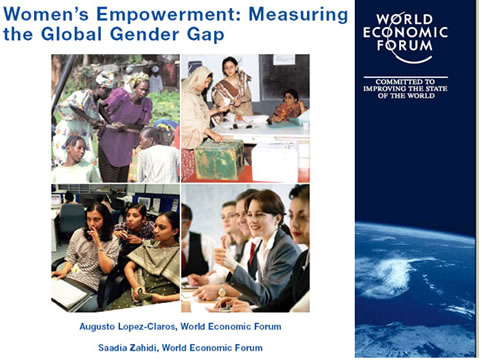As policy-makers and business leaders seek to address talent shortages, it is becoming increasingly urgent to close gender gaps and leverage the talents of both women and men.

THE GLOBAL GENDER GAP REPORT 2014 |
| At the World Economic Forum we recognize that the advancement of women is an important economic, business and societal issue with a significant impact on the growth of nations. Thus, for several years, we have explicitly incorporated aspects of gender equality into our measures of competitiveness and fostered dialogue within our Women Leaders Programme. More recently, we launched our Global Gender Gap Report series, aimed at capturing the magnitude of the gap between women and men in four critical areas: economic participation and opportunity, political empowerment, educational attainment and health and survival. As policy-makers and business leaders seek to address talent shortages, it is becoming increasingly urgent to close gender gaps and leverage the talents of both women and men. |
 |
| Gender-based inequality is a phenomenon that affects the majority of the world’s cultures, religions, nations and income groups. Yet there are differences in the way gender disparities manifest themselves and how they have evolved over time. It is vital to develop frameworks for capturing the magnitude of these disparities in order to design effective measures for reducing them. A challenge that can be measured can be addressed. The Global Gender Gap Index, introduced by the World Economic Forum last year, is one such framework. It aims to be a tool for benchmarking and tracking global gender-based inequalities on economic, political, education- and health-based criteria. | The Global Gender Gap Report 2014
|
The country rankings are meant to serve a dual purpose. They are designed to create greater awareness among a global audience of the challenges posed by gender gaps and the opportunities created by reducing them. It is also hoped that the rankings, together with the detailed country profiles, will serve as a catalyst for change by providing policy-makers with a snapshot of their country’s relative strengths and weaknesses of their country’s performance compared to that of other nations. |
Gaps vs. levels |
||||
| The Index is designed to measure gender-based gaps in access to resources and opportunities in individual countries rather than the actual levels of the available resources and opportunities in those countries. We do this in order to make the Global Gender Gap Index independent of the level of development. In other words, the Index is constructed to rank countries on their gender gaps, not on their development level. | Rich countries have more education and health opportunities for all members of society and measures of levels thus mainly reflect this well-known fact, although it is quite independent of the gender-related issues faced by each country at their own level of income. | The Gender Gap Index, however rewards countries for smaller gaps in access to these resources, regardless of the overall level of resources. For example, the Index penalizes or rewards countries based on the size of the gap between male and female enrolment rates, but not for the overall levels of education in the country. |
Structure of the Global Gender Gap Index |
| Economic Participation and Opportunity | Ratio: female labour force participation over male value Wage equality between women and men for similar work (converted to female-over-male ratio) Ratio: estimated female earned income over male value Ratio: female legislators, senior officials and managers over male value Ratio: female professional and technical workers over male value |
| Educational Attainment | Ratio: female literacy rate over male value
Ratio: female net primary level enrolment over male value Ratio: female net secondary level enrolment over male value Ratio: female gross tertiary level enrolment over male value |
| Political Empowerment | Ratio: females with seats in parliament over male value Ratio: females at ministerial level over male value Ratio: number of years of a female head of state (last 50 years) over male value |
| Health and Survival |
Ratio: female healthy life expectancy over male value Sex ratio at birth (converted to female-over-male ratio) |
| Click here for the Global Gender Gap Index 2007 | ||
| Click here for the Global Gender subindexes for the countries 1 - 31 |
||